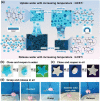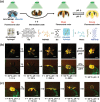Recent Progress in Biomimetic Anisotropic Hydrogel Actuators
- PMID: 30886795
- PMCID: PMC6402410
- DOI: 10.1002/advs.201801584
Recent Progress in Biomimetic Anisotropic Hydrogel Actuators
Abstract
Polymeric hydrogel actuators refer to intelligent stimuli-responsive hydrogels that could reversibly deform upon the trigger of various external stimuli. They have thus aroused tremendous attention and shown promising applications in many fields including soft robots, artificial muscles, valves, and so on. After a brief introduction of the driving forces that contribute to the movement of living creatures, an overview of the design principles and development history of hydrogel actuators is provided, then the diverse anisotropic structures of hydrogel actuators are summarized, presenting the promising applications of hydrogel actuators, and highlighting the development of multifunctional hydrogel actuators. Finally, the existing challenges and future perspectives of this exciting field are discussed.
Keywords: anisotropic structures; biomimetic actuation; hydrogel actuators; stimuli‐responsive hydrogels.
Conflict of interest statement
The authors declare no conflict of interest.
Figures















References
-
- Dumais J., Forterre Y., Annu. Rev. Fluid Mech. 2012, 44, 453.
-
- Elbaum R., Zaltzman L., Burgert I., Fratzl P., Science 2007, 316, 884. - PubMed
-
- Zheng J., Xiao P., Le X. X., Lu W., Théato P., Ma C. X., Du B. Y., Zhang J. W., Huang Y. J., Chen T., J. Mater. Chem. C 2018, 6, 1320.
-
- Holmes D. P., Crosby A. J., Adv. Mater. 2007, 19, 3589.
Publication types
LinkOut - more resources
Full Text Sources
Other Literature Sources
